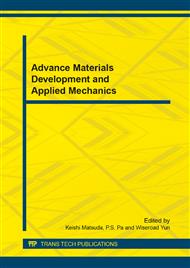p.184
p.188
p.195
p.203
p.208
p.213
p.219
p.223
p.228
Assessment of the Influence of Welding Parameters on Distortion
Abstract:
The welding involves the transfer of high localized heat flow, which results in residual stresses in the welded body. The impossibility of relieving these stresses generates welding distortions that become a problem in dimensional setting of welded structures. This study aims to evaluate the influence of some parameters in the welding process in a T-type joint. Due to the complexity of the welded joint and the deposition rate, a three-dimensional finite element model was developed for the solution of the temperature field and distortions. The transient thermal analysis used the Goldak equation for definition of the heat flux transferred to the part. The nonlinear characteristics of the phenomenon as well as the dependence of physical and mechanical properties with the temperature were considered in this work. The parameters studied were the welding speed, welding sequence and cooling time between weld beads. The results suggest that the higher welding speed, the welding sequence forward and back and with cooling interval between beads present themselves as the best parameters for welding with lower distortions.
Info:
Periodical:
Pages:
208-212
Citation:
Online since:
July 2014
Price:
Сopyright:
© 2014 Trans Tech Publications Ltd. All Rights Reserved
Share:
Citation:


